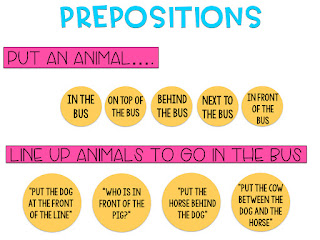Materials needed:
-Book ("Duck and Goose Find a Pumpkin")
-Die cut pumpkins with 1, 2, or 3 step directions written on them OR
-Printable pumpkin pages with directions on them (see further down for the link to download)
Targets:
-Yes/No questions
-Where questions
-Prepositions
-Following directions
-Social interaction
Book: Duck and Goose Find a Pumpkin
I love this book because it's short enough and simple enough for those groups of kids that have realllly short attention spans, and you can target yes/no questions and "where" questions throughout the book.
"Where is Goose?"
"Is the pumpkin in the apple tree?"
Follow-up Activity: Following Directions Pumpkin Patch
Note: While you are reading the book, have the classroom teacher or a para hide the paper pumpkins around the room in places the kids can easily see and access. After reading the book, tell your kids that they're going to all take turns to go to the "pumpkin patch" to find a pumpkin, just like Duck and Goose!
Activity targets: "where" questions, prepositions, following directions
Have your students one by one go find a pumpkin and bring it back to the circle. Ask them where they found it (under the table, on the chair, next to the bookshelf, on the table, on the floor, etc...) to target "where" questions and prepositions.
Next, read the directions and have them follow the two-step direction (or, modify as needed and give only one of the directions) on the pumpkin. Afterwards, that student picks a peer, says their name, and tells them it's their turn. If you have nonverbal kids, give them pictures of two peers to choose from. If that child is mobile, help them give the photo to the peer they chose. Go around until everyone has had a turn to "drive" to the pumpkin patch and get a pumpkin.
Song:
The other day, I heard one of the preschool teachers I work with use a song in her classroom that is perfect for this activity! The kids pretend they're driving a tractor while you sing this song:
Some additional thoughts:
You can have just the child who found the pumpkin follow the direction once they get back to the circle, or have all of the students follow the direction-- I think it really depends on the size of the group and how difficult transitions are. If you have a lot of kids who have a really difficult time with transitions, following directions with steps where they get up from their chair or spot on the rug, such as "stand up" "turn around"/"spin around" or "take a bow" on repeated opportunities may be more than they can handle at this point in time.
On the other hand, having all of the students follow the directions keeps them involved with the activity throughout the whole duration, and if you're counting this time as therapy minutes, you may be able to take data for following directions for multiple students at once. Maybe mix and match-- some directions only the "finder" follows, and others you have the whole group follow.
Free download:
If you don't have access to a die-cut machine, or just want pre-made pumpkins, here are a couple options for you-- blank pumpkins, pumpkins with directions, and pumpkins with QR codes if you want to incorporate technology.
If you use the QR codes, you can tell your kids that the pumpkins all have a "secret message" on it, which they are sure to love! These are text-only, so you don't need wifi to access the message. I prefer the "QR Reader" free app.
Also included in the download are visuals for prepositions to help your kids describe where they found their pumpkin, as well as visuals for yes/no to go along with the book.
These also come in handy for your nonverbal kids to describe where they found the pumpkin-- you can give them two choices, and, if they have a communication device, model the words on their device as applicable (such as "in" or "on") afterwards ("You found it "ON" the table!").
Grab the download here!













































